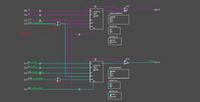kenleigh
Member level 1
My top level module looks like this
Now I have to add a ODDR2 to the output. But I don't know how to link the clk output of the pll CLK_OUTP1 to the input of the ODDR2.
I think I would instantiate a ODDR2 like this
But as you can so I have no idea of what to fill in .Q, .C0 and .C1
Code:
module clkgenerator
( CLK_INP1, CLK_OUTP1, RST, LOCD);
input CLK_INP1, RST;
output CLK_OUTP1, LOCD;
// INST_TAG
clk_wiz_v1_5 camclk
(// Clock in ports
.CLK_IN1 (CLK_INP1), // IN
// Clock out ports
.CLK_OUT1 (CLK_OUTP1), // OUT
// Status and control signals
.RESET (RST), // IN
.LOCKED (LOCD)); // OUT
// INST_TAG_END
endmoduleNow I have to add a ODDR2 to the output. But I don't know how to link the clk output of the pll CLK_OUTP1 to the input of the ODDR2.
I think I would instantiate a ODDR2 like this
Code:
ODDR2
#(
.DDR_ALIGNMENT("NONE"), // Sets output alignment to "NONE", "C0" or "C1"
.INIT(1'b0), // Sets initial state of the Q output to 1’b0 or 1’b1
.SRTYPE("SYNC") // Specifies "SYNC" or "ASYNC" set/reset
) ODDR2_inst (
.Q(//What to fill in here), // 1-bit DDR output data
.C0(//What to fill in here), // 1-bit clock input
.C1(//What to fill in here), // 1-bit clock input
.CE(1'b1), // 1-bit clock enable input
.D0(1'b1), // 1-bit data input (associated with C0)
.D1(1'b0), // 1-bit data input (associated with C1)
.R(1'b0), // 1-bit reset input
.S(1'b0) // 1-bit set input
);But as you can so I have no idea of what to fill in .Q, .C0 and .C1
